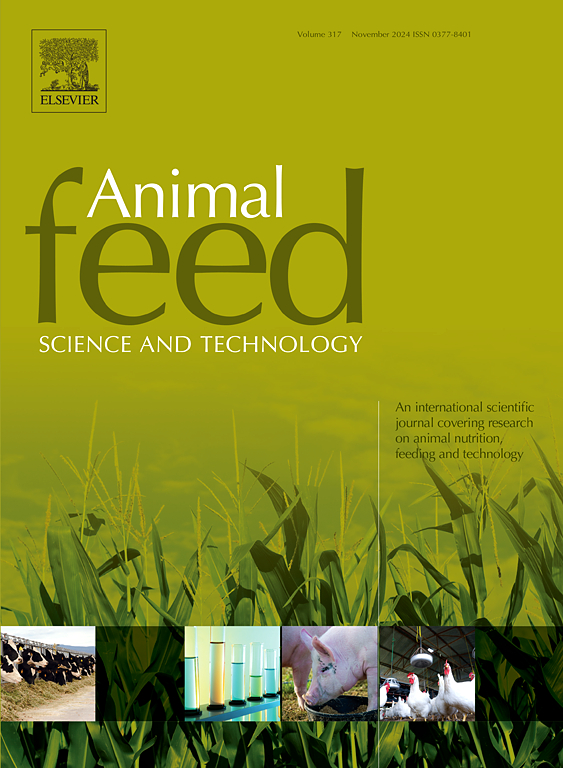在尼罗罗非鱼(Oreochromis niloticus)饲料中添加酿造副产物豆粕,可提高生长性能,提高鱼片蛋白质含量,改善免疫反应,降低肠道pH值
IF 2.7
2区 农林科学
Q1 AGRICULTURE, DAIRY & ANIMAL SCIENCE
引用次数: 0
摘要
本研究旨在评价豆粕作为尼罗罗非鱼幼鱼饲料添加剂的效果。为此,在不同的饲粮水平(0 %、1 %和2 %)下进行了实验性剂量响应生长试验,每个处理有6个重复,持续50天。试验饲料在罗非鱼中反响良好。包含2 %阴沉的饮食导致提高畜牧学的性能(最后重量62.77 ±9.24 ,最终生物量 1129.86±62.41 ,体重增加53.61 ±8.69 ,每日体重增加1.09 ±0.18 )增加蛋白质(15.60 ±0.29 )和磷(2.17 ±0.22 )浓度,并减少脂质(8.21 ±0.76 )内容的尸体。饲粮中添加1 %和2 %的纤维素可增强免疫反应、红细胞计数、血红蛋白水平、白细胞计数、淋巴细胞、血小板,并降低血糖水平。最高水平的豆粕包埋降低了肠道pH值,但在肠道微生物学分析中没有观察到显著差异。结果表明,添加豆粕对尼罗罗非鱼幼鱼的动物技术指标、血液免疫参数和鱼胴体近似组成有积极影响,其在尼罗罗非鱼幼鱼饲料中的添加率高达2% %。本文章由计算机程序翻译,如有差异,请以英文原文为准。
Supplementing the diet of Nile tilapia (Oreochromis niloticus) with trub, a brewing byproduct, enhanced growth performance, increased fillet protein content, improved immunological response, and lowered intestinal pH
The study aimed to assess the impact of trub as a feed additive for juvenile Nile tilapia (Oreochromis niloticus). To this end, an experimental dose![]() response growth assay was conducted with varying dietary levels of 0 %, 1 %, and 2 % trub, each treatment having six repetitions, over a 50-day period. The experimental diets were well-received by the tilapia. Inclusion of 2 % trub in the diet led to improved zootechnical performance (final weight 62.77 ± 9.24, final biomass 1129.86 ± 62.41, weight gain 53.61 ± 8.69, daily weight gain 1.09 ± 0.18) increased protein (15.60 ± 0.29) and phosphorus (2.17 ± 0.22) concentrations, and decreased lipid (8.21 ± 0.76) content in the carcass. Diets with 1 % and 2 % trub enhanced the immunological response, red blood cell count, haemoglobin levels, white blood cell count, lymphocytes, thrombocytes, and lowered blood glucose levels. The highest level of trub inclusion reduced the intestinal pH, but no significant difference was observed in the intestinal microbiological analyses. The results suggest that trub supplementation positively impacted zootechnical indices, haemato-immunological parameters, and fish carcass proximate composition, supporting its incorporation up to 2 % in the diet for juvenile Nile tilapia.
response growth assay was conducted with varying dietary levels of 0 %, 1 %, and 2 % trub, each treatment having six repetitions, over a 50-day period. The experimental diets were well-received by the tilapia. Inclusion of 2 % trub in the diet led to improved zootechnical performance (final weight 62.77 ± 9.24, final biomass 1129.86 ± 62.41, weight gain 53.61 ± 8.69, daily weight gain 1.09 ± 0.18) increased protein (15.60 ± 0.29) and phosphorus (2.17 ± 0.22) concentrations, and decreased lipid (8.21 ± 0.76) content in the carcass. Diets with 1 % and 2 % trub enhanced the immunological response, red blood cell count, haemoglobin levels, white blood cell count, lymphocytes, thrombocytes, and lowered blood glucose levels. The highest level of trub inclusion reduced the intestinal pH, but no significant difference was observed in the intestinal microbiological analyses. The results suggest that trub supplementation positively impacted zootechnical indices, haemato-immunological parameters, and fish carcass proximate composition, supporting its incorporation up to 2 % in the diet for juvenile Nile tilapia.
求助全文
通过发布文献求助,成功后即可免费获取论文全文。
去求助
来源期刊

Animal Feed Science and Technology
农林科学-奶制品与动物科学
CiteScore
6.00
自引率
6.20%
发文量
266
审稿时长
3 months
期刊介绍:
Animal Feed Science and Technology is a unique journal publishing scientific papers of international interest focusing on animal feeds and their feeding.
Papers describing research on feed for ruminants and non-ruminants, including poultry, horses, companion animals and aquatic animals, are welcome.
The journal covers the following areas:
Nutritive value of feeds (e.g., assessment, improvement)
Methods of conserving and processing feeds that affect their nutritional value
Agronomic and climatic factors influencing the nutritive value of feeds
Utilization of feeds and the improvement of such
Metabolic, production, reproduction and health responses, as well as potential environmental impacts, of diet inputs and feed technologies (e.g., feeds, feed additives, feed components, mycotoxins)
Mathematical models relating directly to animal-feed interactions
Analytical and experimental methods for feed evaluation
Environmental impacts of feed technologies in animal production.
 求助内容:
求助内容: 应助结果提醒方式:
应助结果提醒方式:


